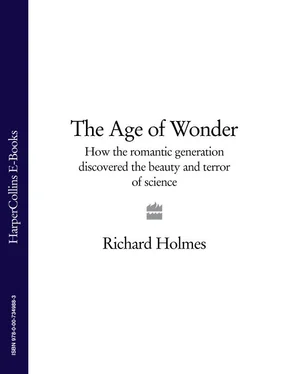Instead, Banks seemed fated to relive his story through the extraordinary lives of his protégés. This is the genial, enabling role he plays in the fantastic series of explorations, expeditions and mind journeys that follow. His great Endeavour voyage had launched an Age of Wonder.
♣ De Bougainville’s account of his ship anchoring at Tahiti for the first time in April 1768 became one of the most celebrated passages in all French romantic travel-writing. ‘I have to admit that it was nigh impossible to keep 400 young Frenchmen at work, sailors who had not seen a woman for six months, in view of what followed. In spite of all our precautions, a young Tahitian girl slipped aboard and placed herself on the quarterdeck immediately above one of the big hatchways, which was fully open to allow air in to the sailors sweating at the capstan below. The young girl casually let slip the only piece of cloth which covered her, and appeared to the eyes of all the crew exactly as naked Venus appeared to the Phrygian shepherd. Truly, she had the celestial form of the goddess of Love. More and more sailors and soldiers crowded to the foot of the hatchway, and no capstan was ever wound with such alacrity as on this occasion. Only naval discipline succeeded in keeping these bewitched young fellows from rioting; and indeed we officers had some little difficulty in restraining ourselves.’ Bougainville, Voyage autour du Monde (1771, Chapter 8, ‘Mouillage à Tahiti’).
♣ A very large ethical and philosophical issue about the nature of justice, property and ownership in society evidently lurked beneath these fleeting reflections of Banks and Cook. Over the next thirty years it would be addressed in various ways by Jean-Jacques Rousseau, Adam Smith, William Godwin and Thomas Paine. Beyond that lay the whole question of imperialism and colonialism, that great, tangled Victorian inheritance, looming like a dark stormcloud on the distant horizon. For the time being the bluff innocence of this first expedition is well caught by Banks’s naval biographer, Patrick O’Brian: ‘In any case the thefts were not all on one side: [Captain] Wallis had taken possession of the entire island [of Tahiti] and its dependencies, which brings to mind the remark about the relative guilt of the man who steals a goose from off a common and the other who steals the common from under the goose.’ Patrick O’Brian, Joseph Banks: A Life (1987), p.95.
♣ It was soon accepted that the Europeans in general were responsible. A satirical poem dedicated to Banks in 1777 had a bitterly sarcastic footnote referring to the transmission of ‘the Neapolitan fever’ to Tahiti, ‘where from the promiscuous intercourse of the Natives, it will probably very soon annihilate them all, and in the most dreadful manner, for the honour of Christian humanity’: ‘An Historic Epistle from Omai to the Queen of Tahiti’ (1777). In addition there is nature’s revenge on marauding European crews, as described in Coleridge’s ballad The Ancient Mariner. It is often forgotten that this poem describes the death of an entire ship’s complement of 200 men (bar the Mariner) after an encounter with a terrifying and diseased woman, ‘Life-in-Death’:
Her lips were red, her looks were free,
Her locks were yellow as gold:
Her skin was as white as leprosy,
The Nightmare Life-in-Death was she,
Who thicks man’s blood with cold.
( The Ancient Mariner, lines 190-4)
The full catastrophe of venereal disease, which devastated the Pacific populations over the next two generations, has been described by Alan Moorehead in The Fatal Impact (1966).
♣ The brief, tentative landings that took place on the coast of ‘New Holland’ (Australia) during May 1770, though they yielded Banks and Solander many prizes in flora and fauna, did not at the time strike Cook with anything like the significance that they would later acquire with the arrival of the First Fleet at Sydney Cove in January 1788. Cook’s long entry for 6 May 1770 gives details of the ‘capacious, safe and commodious’ anchorage at ‘Stingray Harbour’ (firmly renamed ‘Botany Bay’ by Banks), the varied woods and the ‘very beautiful birds such as Cockatoos, Lorryquetes, Parrots etc’, but notes that the Aboriginal inhabitants were both reclusive and hostile, ‘and we were never able to form any connection with them’. By 29 May the Endeavour was already tangled in the maze of perilous shoals leading to the Great Barrier Reef.
♣ All this is quite unlike the wonderful simplicity and directness of Banks’s original Endeavour Journal, and reminds one how delicate the balance-both moral and stylistic-already was between observation and exploitation in these early pioneering days. Banks never wrote about Tahiti again in this mode, though none of his friends (except possibly Solander) would have disapproved of this gentlemanly jeu d’esprit. It has to be added that this is nothing compared to the epistolary lubricities of Banks’s friend Sir William Hamilton. Other influential essays on the South Sea Paradise were published by Bougainville, Denis Diderot and Jean-Jacques Rousseau at this time. Diderot’s Supplement to the Voyage of Bougainville (written in 1772 but not published until 1777) proclaimed Tahiti as a model for the reform of sexual relations in Europe: relaxing the conventions of marriage, promulgating free love between the young, and emphasising the importance of mutual physical pleasure between partners.
♣ Carl Linnaeus (1707-78) emphatically rejected evolution. His ‘systematics’ revealed no connecting law of growth or change, as would the transformational notion explored by several later botanists until Gregor Mendel (1822-84), patiently studying generation after generation of garden peas, gave rigour to the science of genetics. Coleridge pointed to this difference between an organising taxonomy and a dynamic scientific principle or law in essays in The Friend (1819). The psychology of collecting, ordering and naming specimens could also be seen as a form of mental colonising and empire-building. ‘Taxonomy, after all, is a form of imperialism. During the nineteenth century, when British naval surveys were flooding London with specimens to be classified, inserting them in their proper niches in the Linnaean hierarchy, had undeniable political overtones. Take a bird or a lizard or a flower from Patagonia or the South Seas, perhaps one that had had a local name for centuries, rechristen it with a Latin binomial, and presto! It had become a tiny British colony.’ Anne Fadiman, ‘Collecting Nature’, in At Large and at Small (2007), p.19.
♣ It has been conservatively calculated that Banks’s correspondence ran to over 50,000 items, though these are still widely scattered in archives in Britain, America, Australia and New Zealand. See the Joseph Banks Archive Project on the internet. There have been various recent selected editions of his correspondence. These include The Selected Letters of Joseph Banks (2000) and the superb new edition The Scientific Correspondence of Sir Joseph Banks, 1765-1820, in six volumes (2007), both edited by Neil Chambers.
♣ Literally a Paradise Lost, in the sense that venereal disease, alcohol and Christianity had combined by the early nineteenth century to destroy the traditional social structures of Tahiti and to transform its ‘pagan’ innocence forever. The London Missionary Society, founded in 1810, instructed its Tahitian missionaries to ‘cultivate the tenderest Compassion for the wretched condition of the Heathen, while you see them led captive to Satan at his Will. Do not resent their abominations as affronts to yourselves, but mourn over them as offensive to God.’ Charles Darwin visited Tahiti on his way back from the Galapagos islands in November 1835, and later called it ‘Otaheite, that fallen Paradise!’ Alan Moorehead, The Fatal Impact (1966).
Читать дальше












